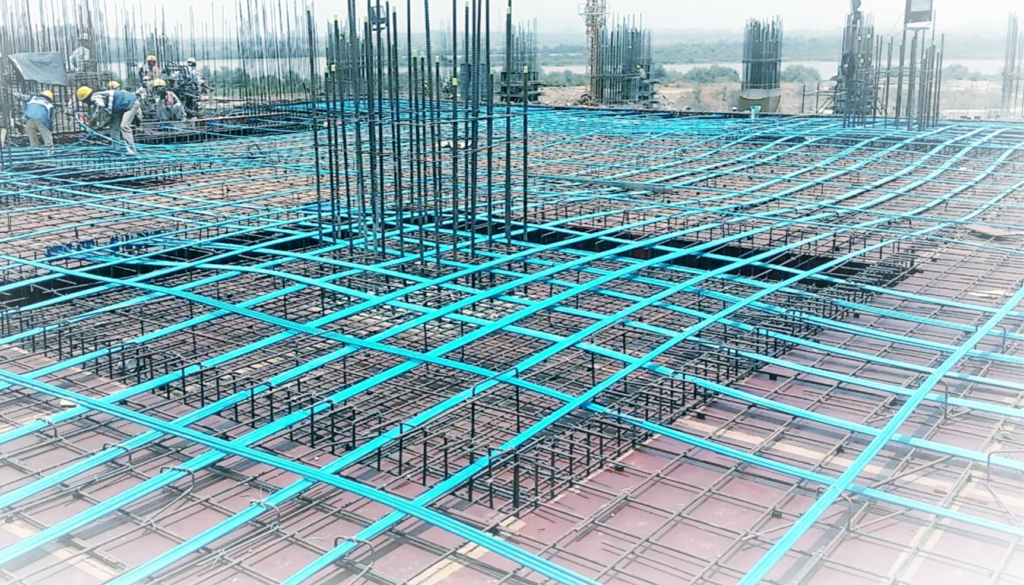Table of Contents
What is Post Tension Slab?
Post tension slab is the combination of conventional RCC slab with steel tandon. Steel tandons provides additional tensile strength to the concrete slab. A significant depth if the slab can be reduced by using steel tandons. This hybridization helps achieve the formation of much thinner slab section over longer spans without unsupported gaps.

Post tension slab is a type of prestressed concrete that provides reinforcement and overcomes concrete weaknesses.
This type of slab is used to make monolithic slab section. Monolithic section is much more stronger compared to tradtional slabs. This is accomplished by laying high-strength steel cables in a criss-cross grid pattern across the slab before pouring the concrete.
Steel tandons have very good ability to resist the tensile load of the structure. After the steel cable grid is completed, concrete is poured over the grid and the cables are embedded in the concrete. Freshly poured concrete can set about 75%. At this point, the cable is tensioned using a hydraulic jack and anchored to the concrete.
The result is a more compacted reinforced concrete slab that helps distribute structural loads over a wider area and reduce cracking.
The tightening process is similar to Chinese finger trap toys in that the trap is actually tightened when the person pulls their finger outward to release it from the trap.
Less excavation and clearing is often required, shortening construction schedules, and monolithic pores help prevent termite infestation.
Working Concept of Post Tension Slab
Compressive strength of concrete and tensile strength of steel help to bear the various types of loads.
When a structure is subjected to significant overload, it puts pressure on the concrete slab, leading to cracking and possibly deformation. To alleviate this problem, prestressed steel cables are installed during pouring and tied with ordinary reinforcing bars after pouring.
When stress is applied to these prestressed reinforcements, the concrete will be crushed. When the concrete is compacted, the compressive strength of the concrete is improved and the tensioned steel fibers also improve the tensile strength. This increases the overall strength of the concrete.
Parts of Post Tension Slab
1. Channel
Thin sheet metal tubes with claw couplings or welded overlap seams of 5 or 6 m lengths are used as standard. The ducts are connected to each other by external threaded connections and sealed with PE tape. There are also plastic ducts on the market today that are waterproof, abrasion resistant and fatigue resistant.
2. Tendon
The basic element of the post-tension system is called the tendon. A tendon consists of one or more prestressed steels covered with a protective coating and housed in a tube or casing.
Prestressed steel is manufactured to the requirements of ASTM A-416 with typical strand sizes of 0.50″ and 0.60″ diameter. A typical steel strand used for post tensioning will be about 243,000 psi. In contrast, typical rebar is around 60,000 psi.
3. Anchor
Anchors are used to secure a strand to concrete while two strands are terminated or connected. The anchorage’s primary function is to transfer stresses to the concrete after stressing is complete.
How to Construct Post Tension Slab?
I have described step by step construction procedure of post tension slab.
- The cables are laid along the traditional frames. The role of cable laying is determined by the engineer. These cables are encased in a plastic or metal sheath so that they are no longer in contact with the water in the concrete.
- One abutment is secured with an anchor and the opposite abutment is left open with a plastic bag mold in which the tendons are worn. Coupling is used between if a create joint is formed.
- Concrete is poured and the alignment of these veins is taken care of so that one can keep them in place. After the concrete reaches 75% strength, about 20 to 23 days, these tendons will be worn away by tension jacking.
- Tension takes place at a pressure equal to 80% of the tensile strength of the yarn. For the standard 270-inch 270 yarn, the yarn is tensioned at a pressure of 33,000 pounds. When tension begins, the metal is stretched and the concrete is compressed.
- When the correct tension is reached, the metal prestress is anchored in place. The anchor is designed to provide a permanent mechanical bond, keeping the metal in tension and the concrete in compression.
- Large veins that go unnoticed at the stop are cut and an equally good grout is placed inside the anchor pocket.
Note: Placing the tensioners inside the concrete and stretching requires professional labor and licensed personnel to perform the tensioning work
Advantages of Post Tension Slabs
- Post tension slabs are superior to other slabs because they provide a very efficient base for floor designs using unsupported spaces with thin slabs and long spans. This gives architects the freedom to design.
- Post tensioning thins the concrete slab, allowing valuable floor-to-floor height savings to be utilized as an additional floor. This allows you to provide additional rental space within the same overall building height.
- Because post-tensioned slabs are thinner, the amount of concrete and reinforcement used is reduced by up to 20% to 30% compared to conventional concrete slabs.
- Stressed plates have less cracking, increased durability, and reduced maintenance costs. Their deflection can be controlled by varying the amount of post tension to compensate for any portion of the load applied immediately after tensioning.
- The demand for post-stress slabs continues to grow around the world due to the tremendous benefits they provide to designers, architects, engineers, contractors and end-users.
Disadvantages of Post Tension Slab
- The construction cost of slab is high.
- It required more skilled workers to construct post tension slab.
- Design of post tension slabs are difficult.
- Structural elements are prone to corrosion.
- Construction is more complex.
